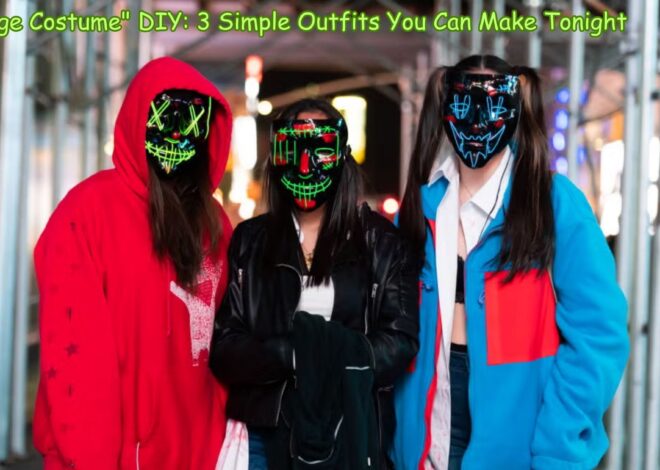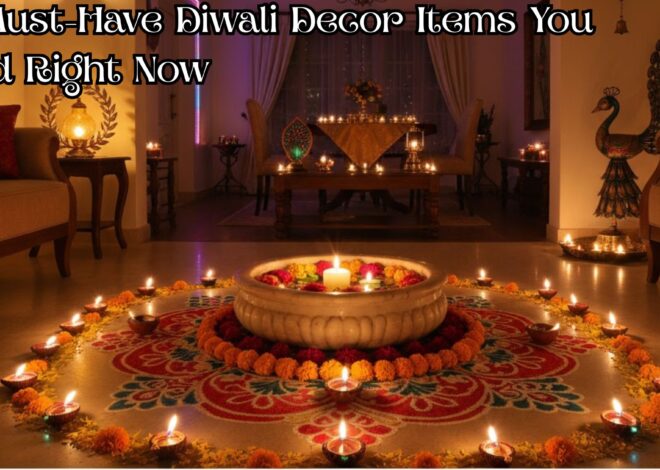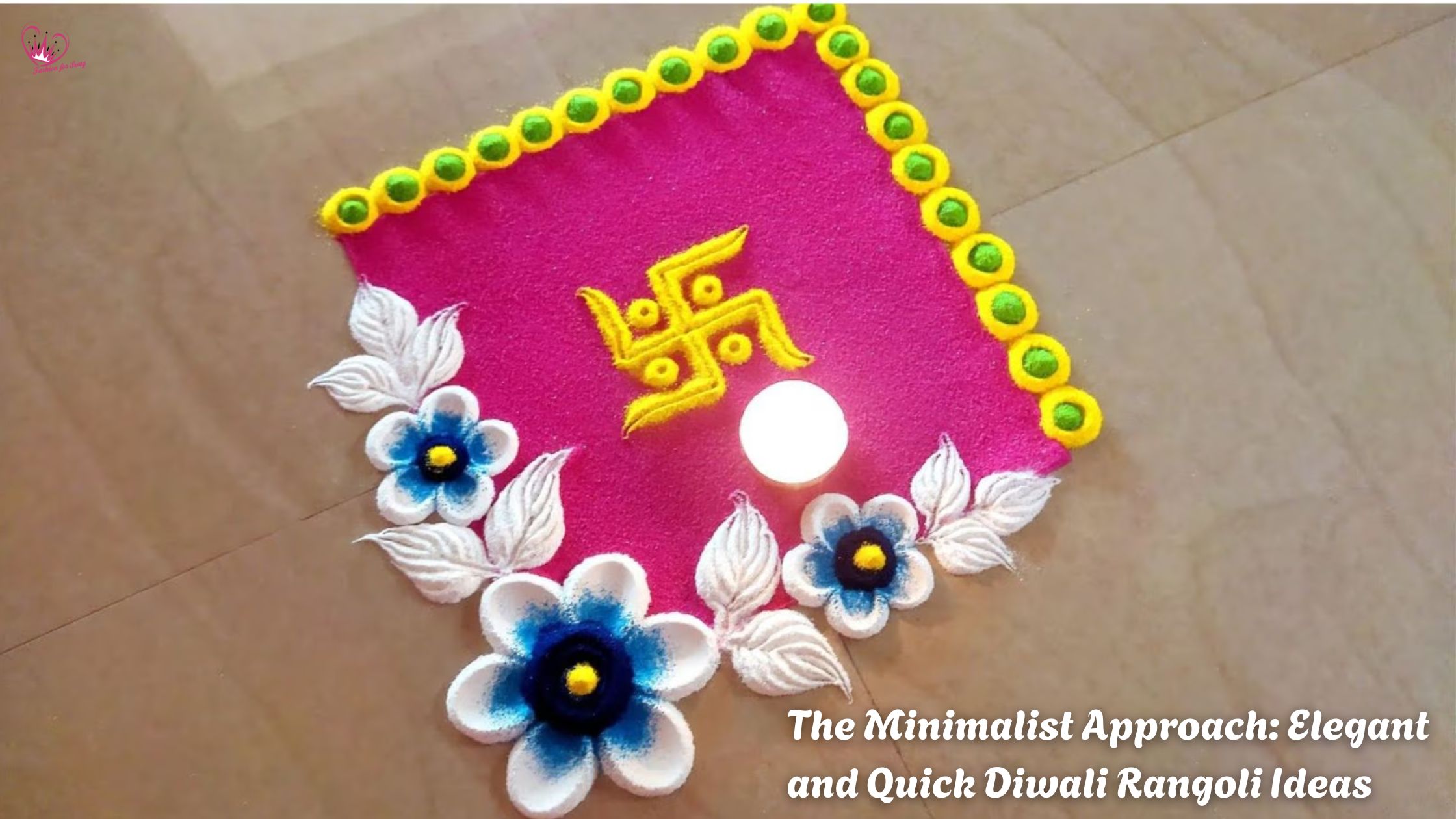
The Minimalist Approach: Elegant and Quick Diwali Rangoli Ideas
Diwali, the festival of lights, is a time to welcome brilliant colours, joyous celebrations and prosperity. While traditional Diwali rangoli ideas are often intricate, detailed, and require hours of painstaking work, modern life often demands a balance between tradition and time constraints. Answer? Minimalist rangoli.
Diwali is not about taking a minimalist approach towards rangoli; It is about achieving maximum beauty with minimum effort. These designs are clean, sophisticated and perfect for small spaces, busy professionals or those who prefer a modern aesthetic that still respects the original traditions of the festival.
By focusing on geometry, symmetry, natural elements, and negative space, you can create a stunning entrance that is both quick to execute and deeply meaningful. This guide dives into the philosophy of minimalist rangoli and offers five functional, quick-to-make designs that will easily brighten up your home this Diwali.
The Philosophy of Minimalist Rangoli
The traditional rangoli – which can cover the entire courtyard – symbolizes the welcoming of Goddess Lakshmi and dispersal of negative energy. A minimalist rangoli achieves this purpose by following basic design principles:
1. Embracing Negative Space
In design, negative space is as important as the design itself. Minimal rangoli uses the clean floor or sidewalk as an important part of the artwork. Rather than filling every inch with color, the focus is on a central motif or border that is visually powerful against a blank background. This approach instantly creates a feeling of sophistication and streamlined elegance.
2. Focus on Geometry and Symmetry
Minimalist designs thrive on great structure. It’s easier and faster to draw circles, squares, triangles and clean lines than complex curves or figurative drawings. Using kitchen tools (such as bottle caps, bowls or plates) to trace the correct shapes quickly ensures symmetry, which is the cornerstone of elegant, streamlined design.
3. Limiting the Color Palette
Instead of using the full spectrum of the rainbow, a minimalist approach limits the palette to two or three main colors.
- Good contrast: Use a dark, rich color (like maroon, saffron, or deep purple) against a light base (white or cream).
- Natural elements: Incorporate the organic textures and colors of flowers (marigold, rose petals) or spices (turmeric, rice flour) to add depth without adding complexity.
4. Maximizing Impact with Diyas
The defining feature of minimalist rangoli is its reliance on diyas (oil lamps) and candles for lighting and effect. Color is the foundation, but light is the spectacle. A simple pattern outlined by 11 or 21 brightly lit lamps can be created far more powerfully and faster than a huge, unlit design.
Five Elegant and Quick Diwali Rangoli Designs
Here are five detailed designs that epitomize the minimalist aesthetic, delivering maximum visual impact with less than 30 minutes of effort.
Design 1: The Concentric Diya Circle
This design is the quintessential instant effect rangoli, taking advantage of the symmetry of the circle and the brightness of the lamp.
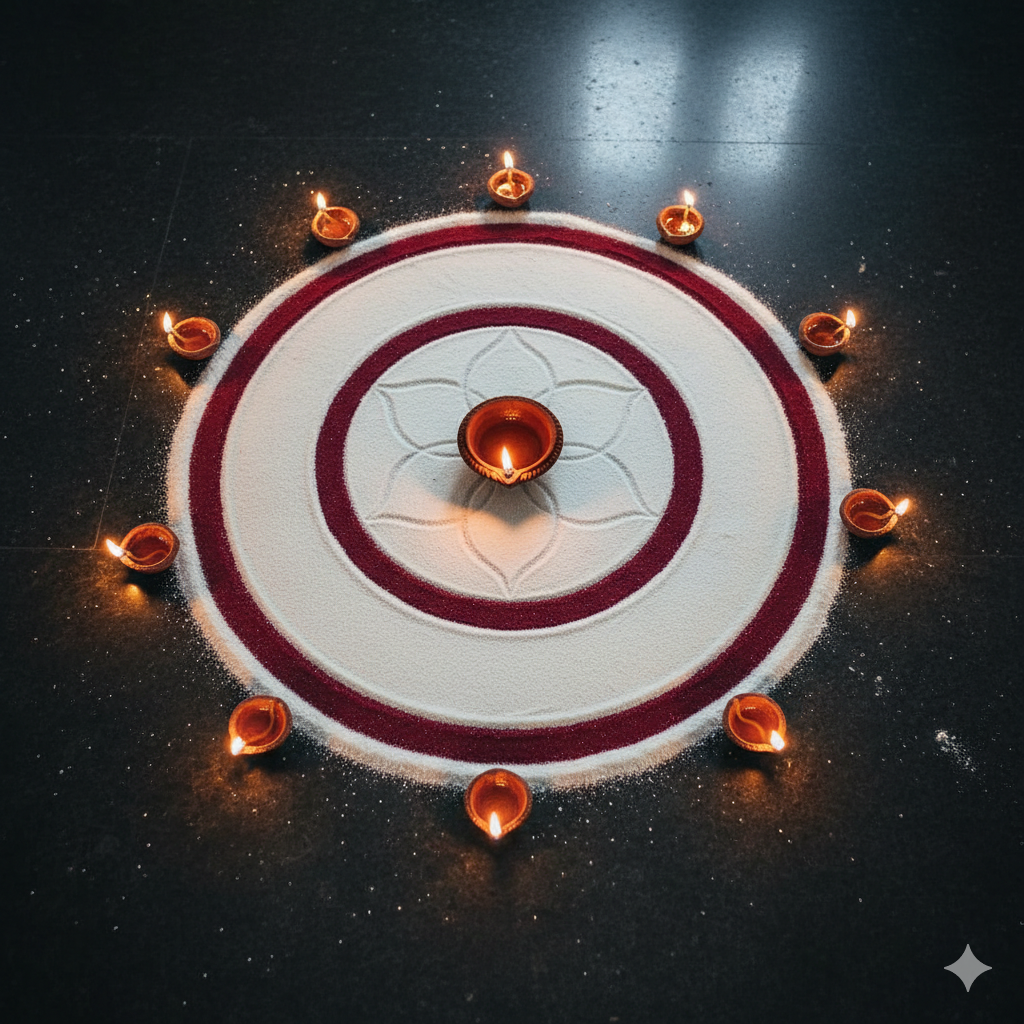
| Component | Steps for Quick Execution |
| Colors | White Rice Flour (Base), Deep Maroon or Red (Contrast) |
| Execution | 1. Base Circle (5 minutes): Place a large dinner plate or a round tray in the center of your space. Trace the outer edge with white rice flour (or chiroti rava for a grainier texture). 2. Contrast Border (10 minutes): Using the same plate or a slightly smaller plate, create a thin, inner border with deep maroon powder. 3. Interior Shape (5 minutes): Using a fork, gently rake or drag five large, evenly spaced dots from the maroon border toward the center to create a subtle lotus-petal effect. |
| Finishing Touch | Place a single, large clay Diya in the absolute center. Line the outer white circle with 7 or 11 small, evenly spaced diyas to frame the design with light. |
Design 2: The Four-Corner Geometric Accent
Perfect for entrances with constrained space, this design focuses on framing the door or the main Diya instead of monopolizing the floor.
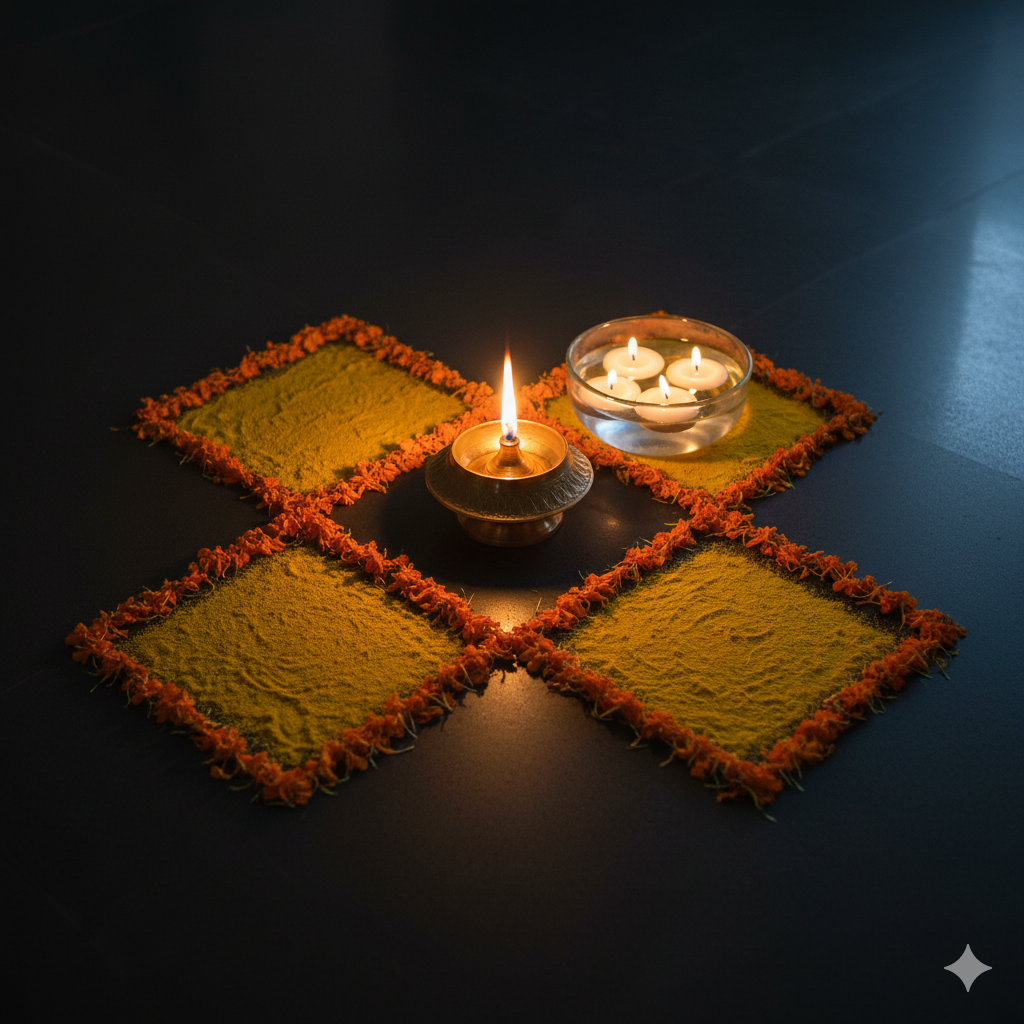
| Component | Steps for Quick Execution |
| Colors | Yellow Turmeric Powder, Marigold Petals, White Chalk |
| Execution | 1. Center (2 minutes): Place a central element (like a small stool or large brass vessel) where your main diya will be placed. 2. Four Squares (10 minutes): In each of the four corners around the central element, use chalk to draw a small, perfect square (about 6 inches per side). 3. Filling and bordering (10 minutes): Fill the inside of each square with yellow turmeric powder. Outline the outer edge of each square with a clean, thin border of marigold petals. |
| Finishing Touch | The central element should be a large brass diya or a bowl filled with water with floating candles. The minimalist power of this design comes from four bright, distinct sections creating a subtle, beautiful border. |
Design 3: The Leaf and Flower Outline
This design uses natural, readily available elements to create a grounded, organic aesthetic that is incredibly quick to execute.
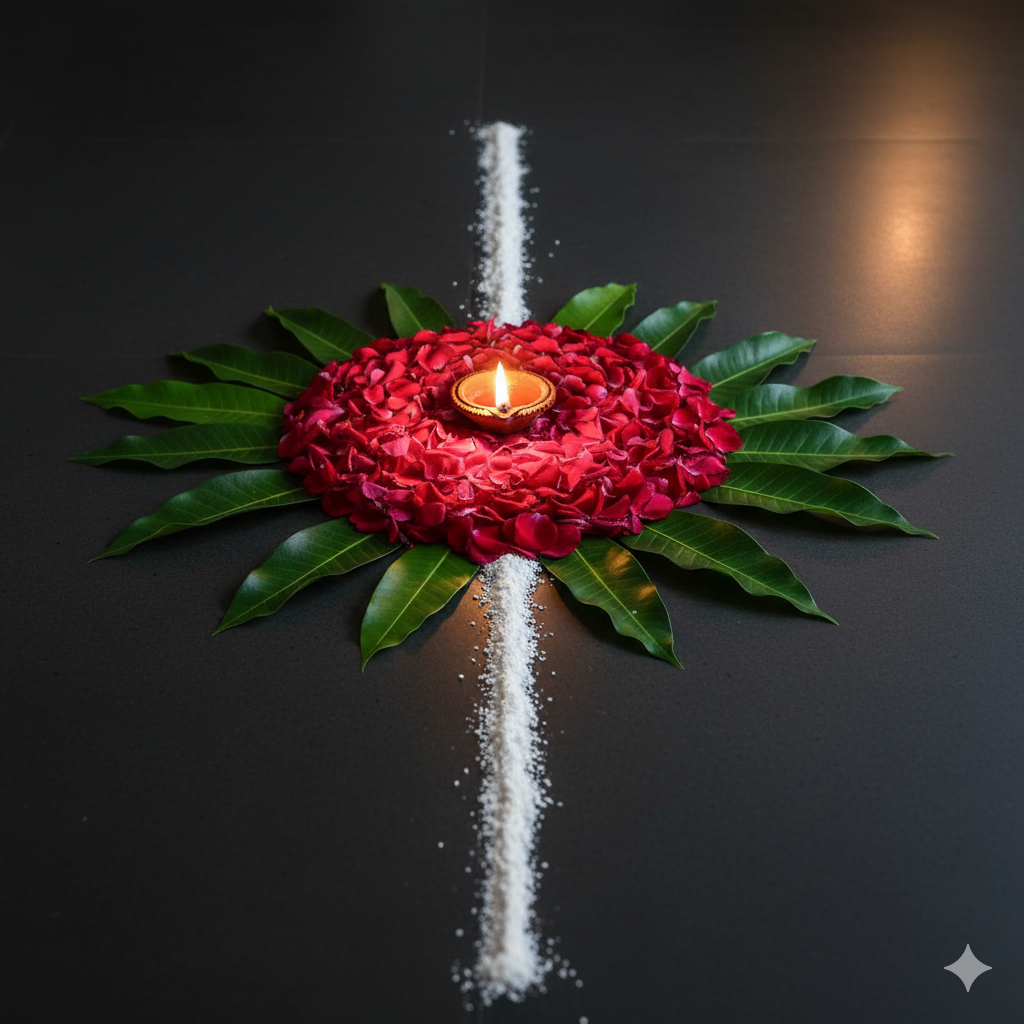
| Component | Steps for Quick Execution |
| Colors | White Rice Flour, Fresh Green Leaves (like mango or rose), Rose Petals (Red/Pink) |
| Execution | 1. Center Line (5 minutes): Starting at the edge of the door, use your fingers to draw a single, neat, thick line of white rice flour that goes straight for about 18 inches, and ends with a small, neat circle. 2. Leaf Border (10 minutes): On both sides of the white line, place small, identical green leaves (or basil leaves for aroma) in an interlocking, alternating pattern. 3. Rosette Center (5 minutes): Fill the last circle at the end of the line neatly with rose petals. |
| Finishing Touch | Place a lamp over a sphere filled with roses. This design focuses on texture and contrast – smooth white, rough green, and soft petals – creating beauty through nature. |
Design 4: The Clean Spiral (Mandala Effect)
The spiral is an ancient, powerful symbol of evolution and cosmic energy. A clean, single-colored spiral is mesmerizing and quick to draw.
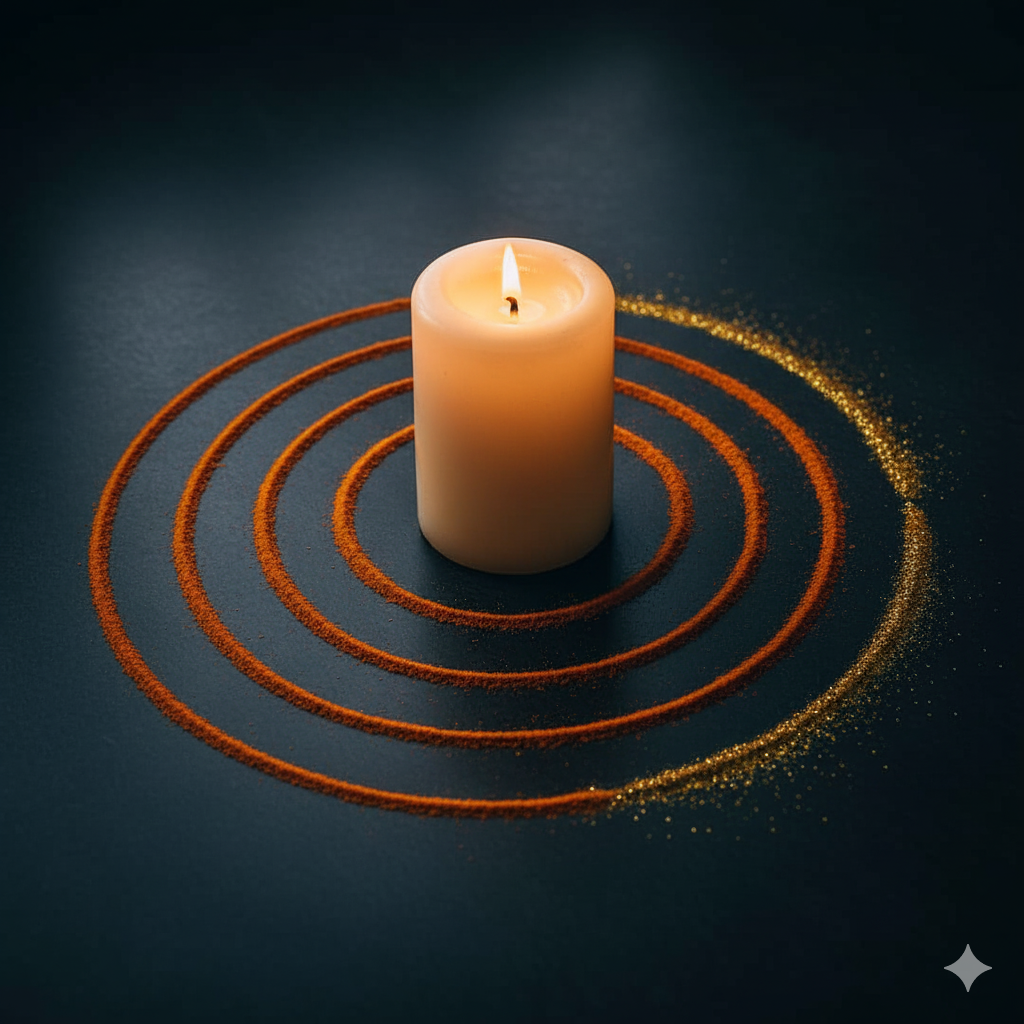
| Component | Steps for Quick Execution |
| Colors | Saffron Orange or Golden Yellow Powder, Sparkly Golden Glitter |
| Execution | 1. Starting Point (5 minutes): Start with a tight dot of your saffron orange powder in the center. 2. Spiral (10 minutes): With a steady hand or using a funnel/cone, slowly move outward in a continuous, even spiral. Maintain a consistent width for the line, allowing significant negative space between revolutions of the spiral. 3. Accent (5 minutes): Lightly sprinkle golden glitter only on the outer edge of the last spiral revolution. |
| Finishing Touch | Place a thick pillar candle in the center. The simplicity of the spiral is its strength, drawing the eye inward and creating a powerful mandala effect that takes minutes, not hours. |
Design 5: The “Om” or Swastika Motif
When time is extremely limited, focus on a single, instantly recognizable and highly auspicious symbol.
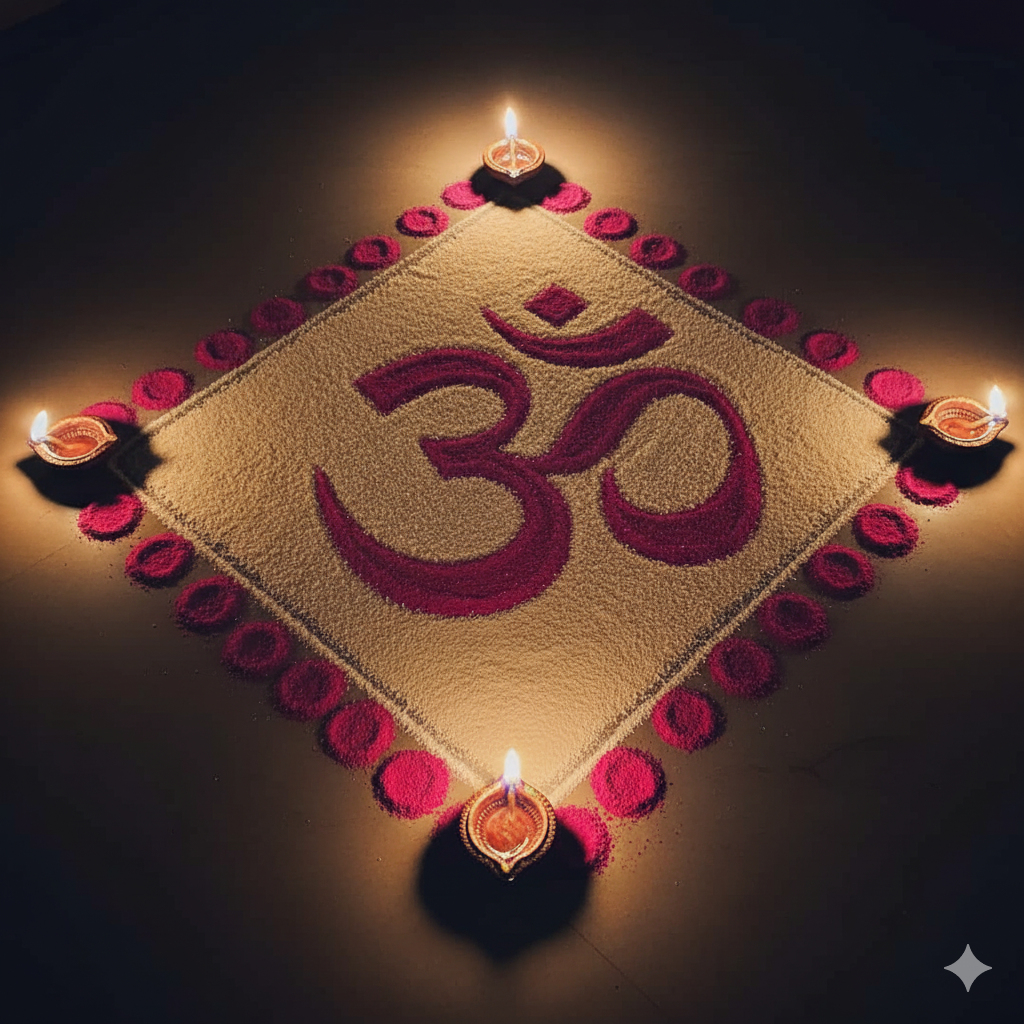
| Component | Steps for Quick Execution |
| Colors | Pink or Magenta Rangoli Powder, Cream-Colored Sand or Sawdust |
| Execution | 1. Outline (5 minutes): Using white chalk or a piece of thin rope for guidance, draw a large, central square. Inside the square, draw the symbol Om (ॐ) or a clean Swastika (卐). 2. Fill (10 minutes): Fill the background of the square with cream-colored sand for a textured, neutral look. Fill in the symbol (Om or Swastika) with contrasting magenta powder. 03. Bordering (5 minutes): Use your finger to make a simple dotted border around the outside edge of the square, keeping the dots larger and evenly spaced. |
| Finishing Touch | Place a lamp at each of the four corners of the square. This rangoli instantly conveys the sacred mood of Diwali while maintaining a modern, impactful block design. |
Essential Tips for Minimalist Execution
The key to a quick and elegant design is preparation and technique.
1. Master the Cone Technique
Forget stirring the powder in with your fingers; This causes uneven lines and wastes time. The best tool for minimalist designs is a powder cone.
- How to: Use a small piece of thick plastic or paper to make a funnel (like a piping bag for icing). Fill it with rangoli powder and make a small hole at the end. It allows you to quickly and accurately draw clean, thin, consistent lines and perfect points.
2. Use Stencils for Speed
For fine, intricate symbols like lotus or Ganesha, don’t use freehand. Buy or make a small, reusable stencil. Place the stencil down, lightly fill it with one color, tap and lift to set it. It guarantees perfection in seconds.
3. Embrace Permanent Bases
For an indoor minimalist rangoli, consider creating a design on a wooden tray or small, round acrylic sheet. This allows you to execute the design in a comfortable space and then carry the finished piece to the entryway, eliminating the need to kneel on the ground and the worry of foot traffic.
4. Color Substitutions for Texture
To avoid the mess of fine rangoli powder, use textures for your minimalist designs:
- Rice grains: Use colored rice grains (dyed with food coloring) for a thick, clean look.
- Pulses/Dals: Different colored lentils (like split peas or chana dal) provide natural, earthy colors and stay in place perfectly, making them ideal for geometric shapes.
Conclusion: Elegance in Simplicity
The beauty of minimalist rangoli is its respect for both tradition and the demands of contemporary life. By prioritizing clean lines, limited color palette and the magnetic glow of the diyas, you can create a welcoming, auspicious and undeniably elegant entrance for Diwali without having to sit on your knees for hours. This year, make your rangoli a testament to the idea that simplicity is the ultimate sophistication. By focusing your energy on a few perfect shapes and bright lights, you make your home a symbol of peace and prosperity, ready to welcome the festival of lights.

